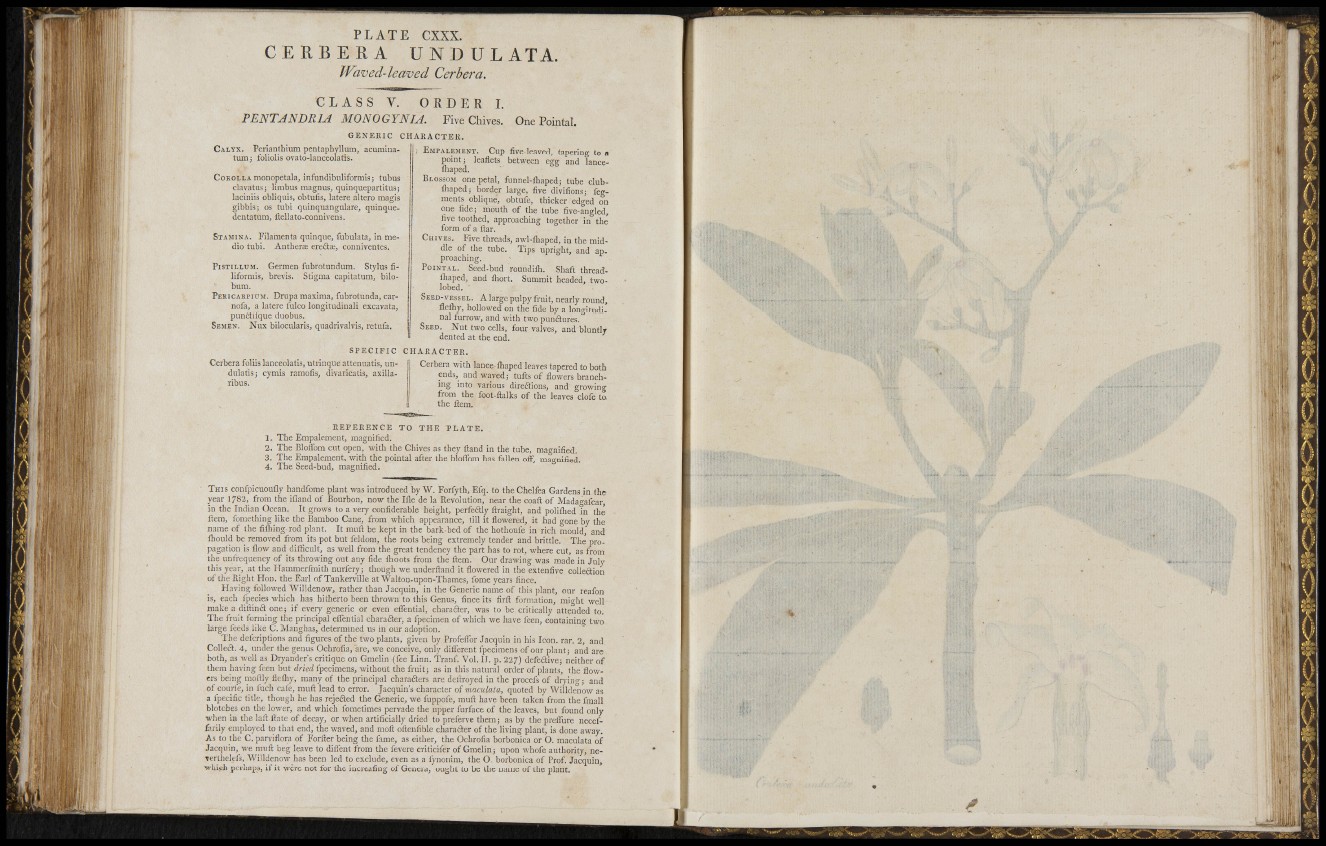
P L A T E CXXX.
G E R B E R A UND U L ATA.
Waved-leaved Gerbera.
C L A S S V. ORDER L
PENTJNDRIA MONOGYNU. Five Chives. One Pointal.
G E N E R I C CHARACTEK.
CALYX. Perianthium pentaphyllum, acuminatum
; foliolis ovato-lanceolatis.
COROLLA monopetala, infundibuliformis; tubus
clavatus; limbus magnuSj quinquepartitus;
laciniis obliquis, obtufis, latere altero magis
gibbis; OS tubi quinquangulare, quinquedentatum,
ftellato-connivens.
STAMINA. Filamenta quinqué, fubulata, in medio
tubi. Antherae erefta;, conniventes.
PisTiLLUM. Germen fubrotundum. Stylus filiformis,
brevis. Stigma capitatum, bilobuni.
PERICAKFIUM. Drupa maxima, fubrotunda, carnofa,
a latere fulco longitudinali excavata,
punétifque duobus.
SEMEN. NUX bilocularis, quadrivalvis, retufa.
Gerbera foliis lanceolatis, utrinque attenuatis, undulatis;
cymis ramofis, divaricatis, axillaribus.
) EMPALEMENT. Cup five leaved, tapering to a
point; leaflets between egg and lanceiliaped.
BLOSSOM one petal, funnel-lliaped; tube clubiliaped;
border large, five divifions; fegments
oblique, obtufe, thicker edged on
one fide; mouth of the tube five-angled,
five toothed, approaching together in the
form of a ftar.
CHIVES. Five threads, awl-lliaped, in the middle
of the tube. Tips upright, and approaching.
P O I N T A L . Seed-bud roundilh. Shaft threadihaped,
and fliort. Summit headed, twolobed.
SEED-VESSEL. A large pulpy fruit, nearly round,
flelhy, hollowed on the fide by a longitudinal
furrow, and with two punftures.
SEED. Nut two cells, four valves, and bluntly
dented at the end.
S P E C I F I C CHARACTEK.
Cerbera with lance-lliaped leaves tapered to both
ends, and waved; tufts of flowers branching
into various direftions, and growing
from the foot-ftalks of the leaves clofe to
the ftem.
R E F E R E N C E TO THE PLATE.
1. The Empalement, magnified.
2. The Bloflbm cut open, witli the Chives as they ftand in the tube, magnified.
3. The Empalement, with the pointal after the bioifom has fallen off, magnified.
4. The Seed-bud, magnified.
T H I S confpicuoufly handfome plant was introduced by W. Forfyth, Efq. to the Chelfea Gardens in the
year 17S2, from the ifland of Bourbon, now the Ifle de la Revolution, near the coaft of Madagafcar,
in the Indian Ocean. It grows to a very confiderable height, perfeaiy ftraight, and poliflied in thé
ftem, fomething like the Bamboo Cane, from which appearance, till it flowered, it had gone by the
name of the fifliing rod plant. It mufl: be kept in the bark-bed of the hothoufe in rich mould, and
fliould be removed from its pot but feldom, the roots being extremely tender and brittle. The propagation
is flow and difficult, as well from the great tendency the part has to rot, where cut, as from
the unFrequeney of its throwing out any fide flioots from the ftem. Our drawing was made in July
this year, at the Hammerfmith nurfery; though we underftand it flowered in the extenfive colleétion
of the Eight Hon. the Earl of Tankerville at Walton-upon-Thames, fome years fince.
Having followed Willdenow, rather than Jacquin, in the Generic name of this plant, our reafon
is, each fpecies which has hitherto been thrown to this Genus, fince its flrft formjition, might well
make a dilHnS one ; if every generic or even eflential, charafler, was to be critically attended to.
The fruit forming the principal eflTential charafter, a fpecimen of which we liave feen, containing two
large feeds like C. Manghas, determined us in our adoption.
The defcriptions and figures of the two plants, given by Profeflbr Jacquin in his Icon. rar. 2, and
Colleil. 4, under the genus Ochrofia, are, we conceive, only different fpecimens of our plant; and arc
both, as well as Dryander's critique on Gmelin (fee Linn. Tranf. Vol. IT. p. 227) defedive; neither of
them having feen but dried fpecimens, v/ithout the fruit; as in this natural order of plants, the flowers
being moftly flelhy, many of the principal charaâers are deflroyed in the procefs of drying; and
of courfe, in luch cafe, muft lead to error. Jacquin's character of macuLata, quoted by Willdenow as
a fpecific title, though he has rejeéled the Generic, we fuppofe, muft have been taken from the fmall
blotches on the lower, and which foraetimes pervade the u])per furface of the leaves, but found only
when in the laft ftate of decay, or when artificially dried to preferve them; as by the preifure neceffarily
employed to that end, the waved, and moft oftenfible charaôter of the living plant, is done away.
As to the C. parviflora of Forfter being tlie fame, as either, the Ochrofia borbonica or O. maculata of
Jacquin, we muft beg leave to dilfent from the fevere criticifer of Gmelin; upon whofe authority, neterthelefs,^
Willdenow has been led to exclude, even as a lynonim, the O borbonica of Prof. Jacquin,
•which perhaps, if it wére not for the increafing of Genera^ ought to be the name of the plant.
'i'ill '
íü lili !sn;r
^ Ï 111 h